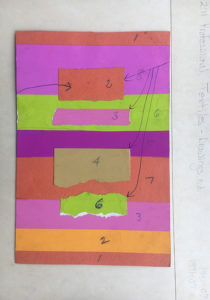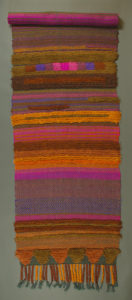Mid-Century Textiles and Global Design at the Cranbrook Academy of Art
EMERGING SCHOLARS > SUMMER RESEARCH GRANTS
by Vishal Khandelwal
For the last leg of my dissertation research on mid-20th-century industrial design in India, I analyzed collections at the Cranbrook Academy of Art in Bloomfield Hills, MI, with the assistance of archivist Laura MacNewman. I examined textile samples, press clippings, photographs of student work, papers of the textile designer Marianne Strengell (1909–1998), administrative files, curriculum brochures, and textiles stored at the Cranbrook Art Museum.
My research yielded both expected and unexpected results. I was keen to understand how the renowned textile innovator Marianne Strengell’s teaching at Cranbrook (figure 1) informed the work of design students Helena Perheentupa from Finland and Nelly Sethna (née Mehta) from India (figure 2), who attended Cranbrook between 1958 and 1960 to study under Strengell. In the late-1960s, Perheentupa and Sethna founded the textiles department at India’s foremost academy of design training, the National Institute of Design (NID), which was established in 1961. In my dissertation, “Belonging Without Aligning: India and the Ethics of Design, 1955–1985,” I explore how global discourses interacted with extant pedagogy to give rise to an original approach to industrial design education in India after the formal end of British colonial rule over the subcontinent in 1947.
While little information exists on Perheentupa in the Cranbrook archives, a number of newspaper articles from the 1950s and 60s mention Sethna’s presence in Michigan. These articles supplement my research in Indian archives, allowing me to better gauge how Sethna’s work was understood and received in both countries. Reviewing the photographs of student work from the late-1950s, I also chanced upon two textiles displayed at the Cranbrook gallery that are very similar to designs made by Sethna for printed textiles around the same time. Inspired by folk arts and crafts, Sethna’s designs were published during the 1960s by Design, a key Indian arts journal.
Strengell’s papers reveal that she participated in efforts to foster craft production in less-developed countries after World War II. One of Strengell’s reports documents her work as a consultant in the Philippines, and press clippings help connect crafts and US diplomacy during the Cold War. After completing her studies at Cranbrook and working in Finland, Perheentupa arrived in India to teach textile design at the NID in 1968. She soon became a core member of a developmentalist education program initiated with the NID’s support in the mid-1970s in Jawaja, a conglomerate of villages located in the western Indian state of Rajasthan.
My archival findings this summer led me to consider how US and Indian design cultures can be further connected through these countries’ mutual embrace of similar industrial design education during the post-World War II period, albeit under very different socio-economic and technical conditions. I am extremely grateful to The Decorative Arts Trust’s Marie Zimmermann Grant for making this work possible that suggests new directions for my research.
Vishal Khandelwal is a PhD Candidate, History of Art, University of Michigan, and a 2019 Marie Zimmermann Grant recipient.
A print version of this article was published in The Magazine of the Decorative Arts Trust, one of our most popular member benefits. Join today!


